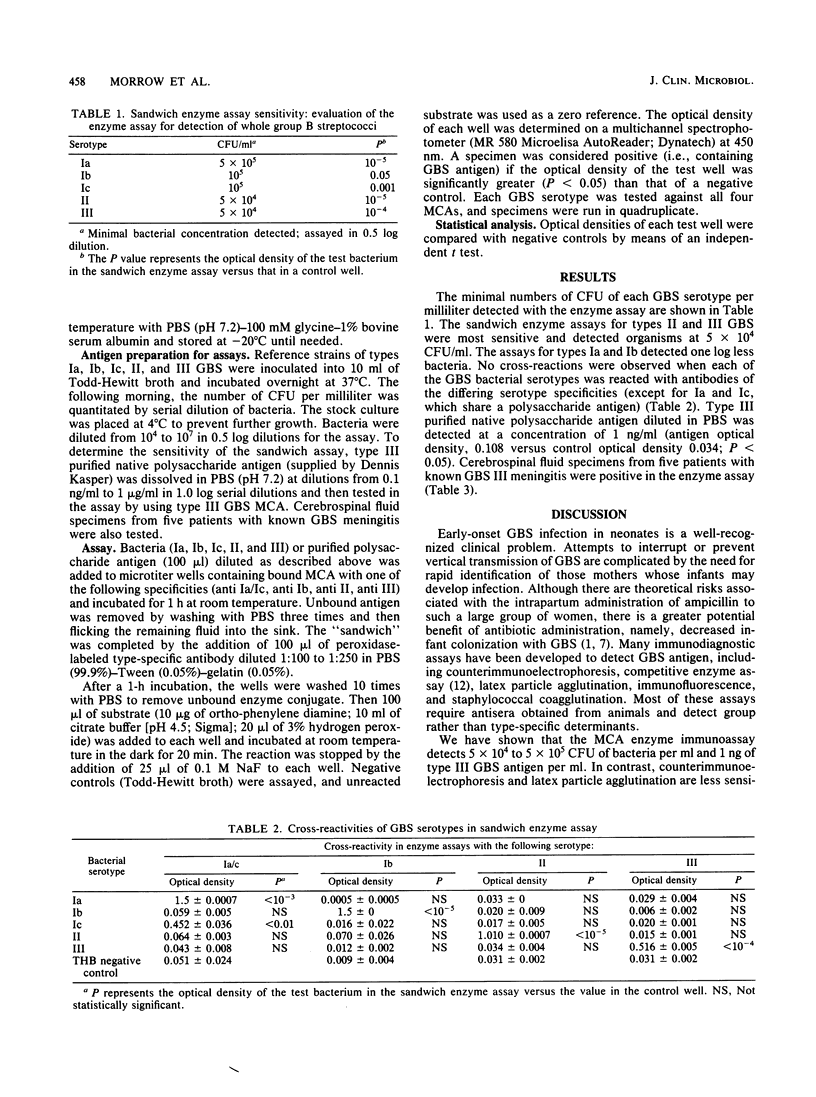Abstract
Group B Streptococcus (GBS) is the most common cause of neonatal sepsis and meningitis. Infants at greatest risk to develop invasive disease are delivered to women colonized with GBS in their birth canals and lacking immunity to the colonizing serotype. We have investigated the sensitivity and specificity of a recently developed monoclonal antibody sandwich enzyme immunoassay for detection of GBS antigen. The sandwich enzyme immunoassay detected types II and III GBS at a concentration of 5 X 10(4) CFU/ml and types Ia and Ib GBS at 5 X 10(5) CFU/ml. No cross-reactions were noted when each of the GBS serotypes was reacted with antibodies of differing serotypes specificities. Type III GBS native antigen was detected at a concentration of 1 ng/ml. The sandwich enzyme assay is more sensitive than other methods currently in use for rapid detection of GBS and is serotype specific. This assay system should prove useful for the detection of GBS colonization during labor and for identification of neonates with invasive disease.
Full text
PDF


Selected References
These references are in PubMed. This may not be the complete list of references from this article.
- Baker C. J. Interview with Carol J. Baker, M.D. Prevention of neonatal Group B streptococcal disease. Pediatr Infect Dis. 1983 Jan-Feb;2(1):1–5. [PubMed] [Google Scholar]
- Baker C. J., Rench M. A. Commercial latex agglutination for detection of group B streptococcal antigen in body fluids. J Pediatr. 1983 Mar;102(3):393–395. doi: 10.1016/s0022-3476(83)80657-x. [DOI] [PubMed] [Google Scholar]
- Baker C. J., Webb B. J., Jackson C. V., Edwards M. S. Countercurrent immunoelectrophoresis in the evaluation of infants with group B streptococcal disease. Pediatrics. 1980 Jun;65(6):1110–1114. [PubMed] [Google Scholar]
- Boyer K. M., Gadzala C. A., Kelly P. C., Burd L. C., Gotoff S. P. Rapid identification of material colonization with group B streptococci by use of fluorescent antibody. J Clin Microbiol. 1981 Nov;14(5):550–556. doi: 10.1128/jcm.14.5.550-556.1981. [DOI] [PMC free article] [PubMed] [Google Scholar]
- Castle C., Deeley J., Easmon C. S. Grouping and detection of group B streptococci by immunofluorescence. J Clin Pathol. 1983 Apr;36(4):463–465. doi: 10.1136/jcp.36.4.463. [DOI] [PMC free article] [PubMed] [Google Scholar]
- Edwards M. S., Kasper D. L., Baker C. J. Rapid diagnosis of type III group B streptococcal meningitis by latex particle agglutination. J Pediatr. 1979 Aug;95(2):202–205. doi: 10.1016/s0022-3476(79)80651-4. [DOI] [PubMed] [Google Scholar]
- Ferrieri P., Cleary P. P., Seeds A. E. Epidemiology of group-B streptococcal carriage in pregnant women and newborn infants. J Med Microbiol. 1977 Feb;10(1):103–114. doi: 10.1099/00222615-10-1-103. [DOI] [PubMed] [Google Scholar]
- Ingram D. L., Suggs D. M., Pearson A. W. Detection of group B streptococcal antigen in early-onset and late-onset group B streptococcal disease with the Wellcogen Strep B latex agglutination test. J Clin Microbiol. 1982 Oct;16(4):656–658. doi: 10.1128/jcm.16.4.656-658.1982. [DOI] [PMC free article] [PubMed] [Google Scholar]
- Leland D. S., Lachapelle R. C., Wlodarski F. M. Method for rapid detection of group B streptococci by coagglutination. J Clin Microbiol. 1978 Apr;7(4):323–326. doi: 10.1128/jcm.7.4.323-326.1978. [DOI] [PMC free article] [PubMed] [Google Scholar]
- Polin R. A., Kennett R. Use of monoclonal antibodies in an enzyme immunoassay for rapid identification of group B Streptococcus types II and III. J Clin Microbiol. 1980 Apr;11(4):332–336. doi: 10.1128/jcm.11.4.332-336.1980. [DOI] [PMC free article] [PubMed] [Google Scholar]
- Polin R. A., Kennett R. Use of monoclonal antibodies in an enzyme-linked inhibition assay for rapid detection of streptococcal antigen. J Pediatr. 1980 Oct;97(4):540–544. doi: 10.1016/s0022-3476(80)80005-9. [DOI] [PubMed] [Google Scholar]
- Pyati S. P., Pildes R. S., Jacobs N. M., Ramamurthy R. S., Yeh T. F., Raval D. S., Lilien L. D., Amma P., Metzger W. I. Penicillin in infants weighing two kilograms or less with early-onset Group B streptococcal disease. N Engl J Med. 1983 Jun 9;308(23):1383–1389. doi: 10.1056/NEJM198306093082303. [DOI] [PubMed] [Google Scholar]
- Ryan M. E., Barrett F. F. Rapid detection of group B streptococcal colonization by a direct immunofluorescent antibody technique. J Pediatr. 1982 Dec;101(6):993–995. doi: 10.1016/s0022-3476(82)80028-0. [DOI] [PubMed] [Google Scholar]
- Slifkin M., Freedel D., Gil G. M. Direct serogrouping of group B streptococci from urogenital and gastric swabs with nitrous acid extraction and the Phadebact streptococcus test. Am J Clin Pathol. 1982 Dec;78(6):850–853. doi: 10.1093/ajcp/78.6.850. [DOI] [PubMed] [Google Scholar]
- Yow M. D., Mason E. O., Leeds L. J., Thompson P. K., Clark D. J., Gardner S. E. Ampicillin prevents intrapartum transmission of group B streptococcus. JAMA. 1979 Mar 23;241(12):1245–1247. [PubMed] [Google Scholar]


